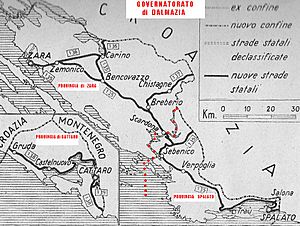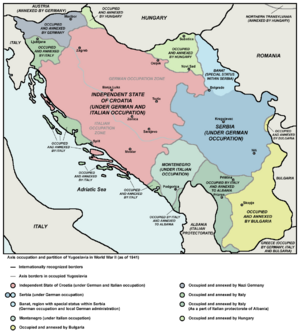Cattaro (Italian province) facts for kids
The Cattaro (Italian province), known in Italian as Provincia italiana di Cattaro, was a special area created by the Kingdom of Italy during World War II. It was part of a larger region called the Governorate of Dalmatia. This province was officially formed on May 18, 1941, by a special Italian law.
What it Was Like
This new province of Cattaro was quite small. It covered about 547 square kilometers (211 square miles) and had nearly 39,800 people living there. Its borders were very similar to an old area called the Albania veneta, which was part of the Republic of Venice until 1797 in southern Dalmatia.
The province included cities like Cattaro (now Kotor), Perasto (Perast), Risan, Teodo (Tivat), and Castelnuovo di Cattaro (Herceg Novi). Most of the people living there were Slavs. However, there were also about 3,000 local Italians. These Italians were descendants of people who had lived in Dalmatia since Roman times. They mostly lived in the areas of Cattaro and Perasto. A small island called Saseno, located in Albania, was also added to this province. Before this, Saseno had been part of another Italian province called Zara since 1920.
Its History
In April 1941, Italian General Vittorio Ambrosio quickly took control of the Dalmatian coast of Yugoslavia. He also occupied the area around Cattaro, which had been known as "Kotor" since 1919.
The new Italian province of Cattaro was created the very next month. This happened by order of the Italian leader Benito Mussolini, as part of the "May 19 Treaty between Italy and Croatia." Francesco Scassellati Sforzolini was chosen to be the "Prefect" (like a governor) of the Cattaro province. He held this position from June 1941 to June 1943.
The main governor for the entire Governorate of Dalmatia, which included Cattaro, was Giuseppe Bastianini. He served until January 1943. After that, Francesco Giunta took over as governor.
In the summer of 1941, the Italian government began a plan to make the region more Italian. New Italian schools were opened in the "Bocche di Cattaro" area (also known as Boka Kotorska). Many Italian officials and workers moved to Cattaro city. Some 6,700 Dalmatian Italians had moved to Italy after Yugoslavia was formed in 1919. Many of them were offered jobs if they returned to live in the Governorate of Dalmatia. Governor Bastianini also started important public projects, like building hospitals, sewage systems, and roads in the area.
About 500 Jewish people found safety in the Cattaro province. They had escaped danger and harassment from the Ustasha and Nazi Germans in other parts of former Yugoslavia.
The province of Cattaro was mostly spared from the intense fighting that happened in other parts of Italian-occupied Montenegro. This lasted until mid-September 1943. At that time, German forces took control of the area, and the Italian province of Cattaro officially ended. The Italian "Emilia" Division fought against the German occupation of the province. From September 9 to September 16, 1943, they had 597 soldiers killed and 963 wounded.
Towns of the Province of Cattaro
There were 15 "comuni" (towns or municipalities) in the Italian Province of Cattaro. The first name is in Italian, followed by the Montenegrin-Serbian and Croatian names:
- Cattaro / Cotor (Kotor)
- Cartolle / Krtole
- Castelnuovo di Cattaro / Hercegnovi (Herceg Novi)
- Dobroto / Dobrota
- Gruda / Gruda
- Lastua Inferiore / Donia Lastovo (Donja Lastva)
- Lustizza / Lustiza (Luštica)
- Mulla / Muo
- Perasto / Perast
- Perzagno / Prčanj
- Risano / Risan
- Stolivo Inferiore / Donji Stoliv
- Sutorina / Sutorina
- Teodo / Tivai (Tivat)
- Zuppa / Grbali
Related pages



